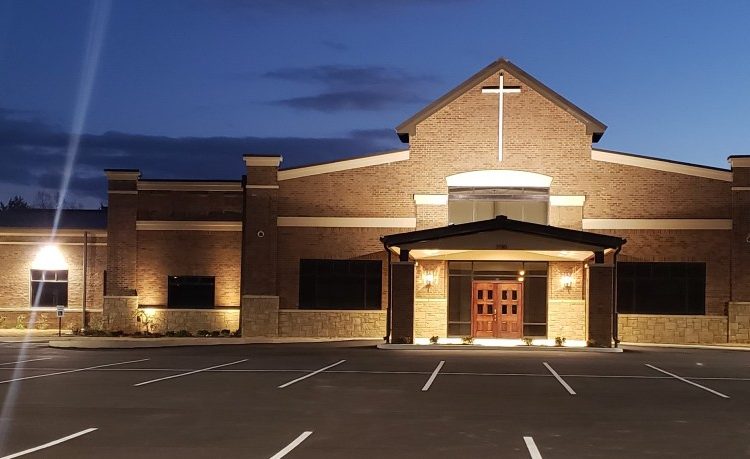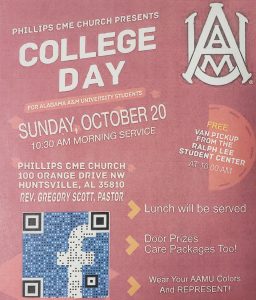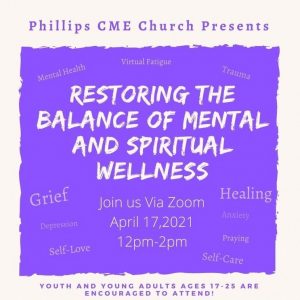Imagining the Possibilities: Cultivating a Nurturing Environment
for a College Ministry
The Black Church has been and continues to be a central force that undergirds the African American community. It was within the sacred spaces and places of the Black Church that generations of African Americans reimagined the message and mission of Christ to develop a nurturing environment that instilled the values of intrinsic worth, divine purpose, and identity formation.[1] The nurturing environment of the Black Church is the setting where leaders are developed, children educated, and people are inspired to hope. Therefore, Phillips Christian Methodist Episcopal (CME) Church seeks to cultivate a nurturing environment that will promote the development of an intergenerational college ministry. A college ministry that is undergirded by the theological tenets of the Christian faith and the liberating, transformational, and empowering heritage of the Black Church.
The Beginning
Former slaves organized Phillips CME Church in 1865 in Huntsville, AL. The organization of the church and the CME denomination in the aftermath of the American Civil War and amidst the challenges of the Reconstruction Era is foundational to the congregation’s identity, mission, and focus in ministry. Currently, the church is located one mile from the campus of AAMU, a Historically Black University (HBCU), which will allow it to imagine new ministry possibilities with the students, faculty, and staff of the university.
The Challenge
Over the past few years in the United States, there has been a rapid decline in the number of persons who identify themselves as Christian and who attend church consistently. This decline has taken place across denominational and racial lines. The question many churches and denominations are asking is how do we slow this decline? I believe Generation Z, those born between 1997 and 2012, will be the key. It is projected that Generation Z will become a third of the population by 2020.[2] From this viewpoint, Generation Z becomes vital to the growth and sustainability of many denominations and churches in the future.

Photo by Sincerely Media on Unsplash
Research has shown that Generation Z is spiritual, but they have become disillusioned with institutional or mainline religion.[3] Therefore, it is crucial that mainline Christian denominations and churches become intentional in building relationships and creating safe environments where Generation Z can be authentic. The lack of participation by Generation Z means the church is missing their voices and insight. However, it also means that Generation Z is missing out on experiencing the fellowship, love, spiritual enlightenment, and cultural consciousness that are benefits of being connected to a nurturing faith community.
A Way Forward
The limited number of Generation Z in Phillips CME Church becomes an opportunity for the church to devise a strategy and develop a ministry that focuses on Generation Z, especially college students at AAMU. An intergenerational college ministry allows the life experiences and intellectual knowledge of previous generations to be spiritually enriching and socially empowering.[4] The uniqueness and worldview of college students can help previous generations better understand and reimagine the complexities of the current social climate that is affecting African American communities. An intergenerational college ministry can be the pathway that becomes a journey of new discovery and the catalyst that changes the world.
The Journey
The first step in developing a college ministry was to assemble a college ministry team that consisted of congregants and college students. The assembling of this team created an atmosphere where ownership of the project, accountability to the goal, and leadership development empowered the team to imagine possibilities.[5] It also laid the groundwork for future ministries. To have college students present on the team brings a new perspective that allows the college ministry to be relevant and empowering to their generation. The primary goal of the team was to build community through building trust, which leads to success.

Photo by Natalie Pedigo on UnsplashImage created by Gregory Scott
The college ministry team adopted the concepts of “Sankofa” and “Ubuntu” to guide the team and the ministry’s interactions. Sankofa centers on the truth of remembering the past and taking from it all that is good, bringing it into the present as one progresses toward a purposeful future.[6]
Ubuntu means, “I am because we are, and because we are therefore I am.”[7] Sankofa and Ubuntu acknowledges the intergenerational importance of the college ministry.
The Bridge
Designing and implementing a college ministry that is relevant and sustaining must focus on cultivating a “nurturing environment” within the church. To cultivate is to encourage growth by being attentive to the tenets of the faith and the heritage of the congregation that already exists.
A nurturing environment is a welcoming atmosphere that allows people of different social classes, races, ethnicities, genders, sexuality, and religious affiliation to feel included and accepted, which creates a sense of belonging.[8] A welcoming atmosphere also includes practicing radical hospitality that encompasses being in partnership with God, which brings justice and healing to transform the world.[9] When a nurturing environment is welcoming and practices radical hospitality, it becomes a powerful witness to the community and the world to imagine new possibilities.
A nurturing environment is a space of hope.[10] To create a space and a place of hope becomes inspirational to those whom the greater society has marginalized. Therefore, a nurturing community centered in hope uses the lens of faith and love to push beyond the systems, structures, and attitudes that devalue people.

Photo by Ehimetalor Akhere Unuabona on Unsplash
Image created by Gregory Scott
A nurturing environment is identity forming as it becomes a journey of new discovery. An important element of identity formation is intergenerational dialog that is infused with storytelling. [11] The collaborative atmosphere of a nurturing environment involves sharing life experiences, knowledge, and coping skills so everyone can survive and thrive.
The Discovery
Being the church is no simple task, especially amid the social unrest and the global pandemic of 2020–2021, a period which part of this project occurred. The COVID-19 virus restrictions meant that organizations had to reimagine processes to meet the challenges of the day and stay relevant in a changing world. Despite the challenges, the principles of a nurturing environment was shared through sermons, teaching opportunities, and meetings on the church’s virtual platforms.
This project has proven that hosting a College Day and sharing a communal meal with college students has proven to be an excellent practice for breaking down the walls of separation and building relationships. The college ministry team has used all available platforms to continue planning and implementing workshops, focus groups, forums, and opportunities to expand the college ministry.
I believe the Church must consider what it means to be the church in the twenty-first century, especially if it is to reclaim and keep persons from Generation Z. I believe the focus should lean toward community interactions that build relationships. It is in and through the building of relationships that the church regains its relevance as a change agent in the world. The cultivation of a nurturing environment and investing in a ministry with Generation Z, especially college students, will open the door for the church to imagine new possibilities.
[1] L. H. Whelchel Jr., The History and Heritage of African American Churches: A Way Out of No Way (Saint Paul, MN: Paragon House, 2011), 233.
[2] Meghan Grace and Corey Seemiller, Generation Z Goes to College (San Francisco, CA: Jossey-Bass, 2016), 6.
[3] Grace and Seemiller, Generation Z Goes to College, 42.
[4] F. Douglas Powe Jr., New Wine New Wineskins: How African American Congregations Can Reach New Generations, (Nashville, TN: Abingdon Press, 2012) 35.
[5] Boyung Lee, Transforming Congregations Through Community: Faith Formation from the Seminary to the Church (Louisville, KY: Westminster John Knox Press, 2013), 110.
[6] Appiah K Kwartang, “The Sankofa Bird and Reflection,” The Journal of Applied Christian Leadership 10, no. 1 (2016): 60, https://login.proxy.library.emory.edu/login?url=http://search.ebscohost.com/login.aspx?direct=true&db=lsdar&AN=ATLAiFZK181231001118&site=ehost-live&scope=site.
[7] “‘I Am Because We Are’: The African Philosophy of Ubuntu,” To the Best of Our Knowledge, September 30, 2020, https://www.ttbook.org/interview/i-am-because-we-are-african-philosophy-ubuntu.
[8] David J. Bosch, Transforming Mission: Paradigm Shifts in Theology of Mission (Maryknoll, NY: Orbis Books, 2012), 28.
[9] Letty Russell, Just Hospitality: God’s Welcome in a World of Difference (Louisville, KY: Westminster John Knox Press, 2009), 2.
[10] Sandra L. Barnes, Karma D. Johnson, and Anne E. Streaty Wimberly, Youth Ministry in the Black Church: Centered in Hope (Valley Forge, PA: Judson Press, 2013), 7.
[11] Evelyn L. Parker, “Bridging Civil Rights and Hip-Hop Generations,” in Black Practical Theology. ed. Dale P. Andrews and Robert London Smith, Jr. (Waco, TX: Baylor University Press, 2015), 31.
Further Reading:
Ammerman, Nancy T., and Carl S. Dudley. Congregations in Transition: A Guide for Analyzing, Assessing, and Adapting in Changing Communities. San Francisco: Jossey-Bass, 2002.
Andrews, Dale P., and Robert London Smith, Jr. Black Practical Theology, edited by Dale P. Andrews and Robert London Smith, Jr. Waco, TX: Baylor University Press, 2015.
Barnes, Sandra L., Karma D. Johnson, and Anne E. Streaty Wimberly. Youth Ministry in the Black Church: Centered in Hope. Valley Forge, PA: Judson Press, 2013.
Ellison II, Gregory C. Cut Dead but Still Alive: Caring for African American Young Men. Nashville: Abingdon Press, 2013.
Grace, Meghan, and Corey Seemiller. Generation Z Goes to College. San Francisco: Jossey-Bass, 2016.
Powe Jr., F. Douglass. New Wine New Wineskins: How African American Congregations Can Reach New Generations. Nashville: Abingdon Press, 2012.






